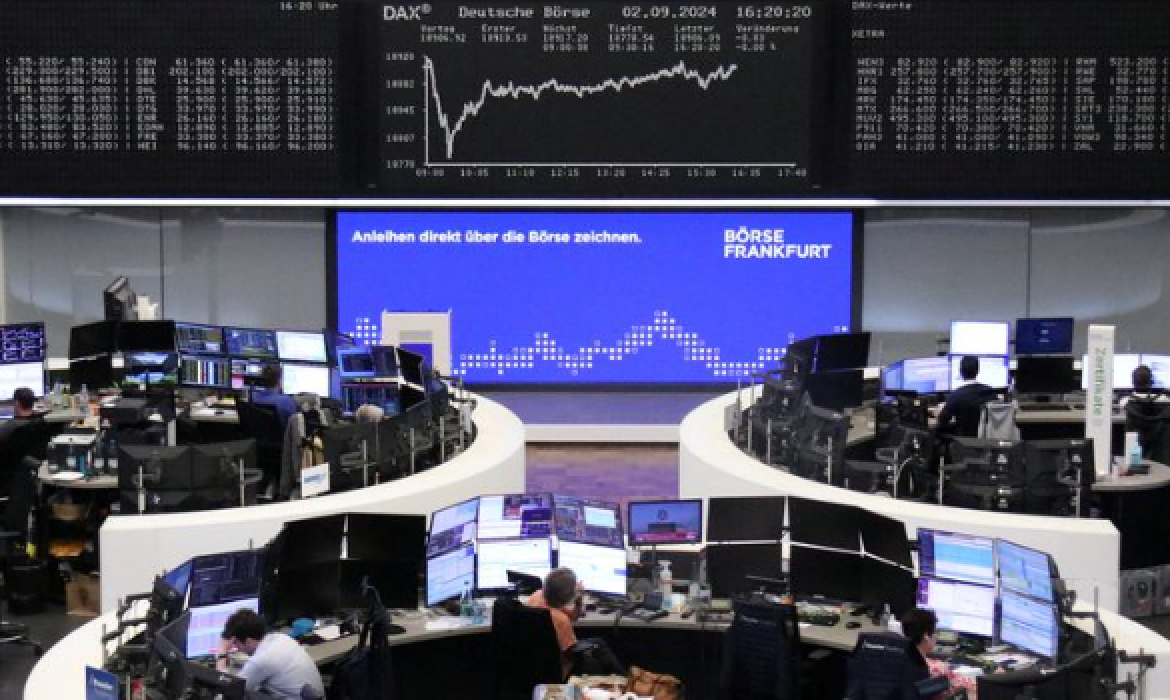Daily Synopsis of the New York market close – Feb 18, 2025
Date Issued – 18th February 2025
Preview
Asian stocks surged, led by Hong Kong markets, as a meeting between President Xi Jinping and business leaders, including Jack Ma, fueled hopes for a softened stance on private enterprise, driving a $1 trillion tech rally. Goldman Sachs raised its gold price target to $3,100, citing central-bank buying and inflation fears. Indonesia mandated onshore retention of exporters’ FX earnings to stabilize the rupiah, but exporters may face cash flow challenges. Chinese convertible bonds climbed 3.3% this year, boosted by AI optimism and Beijing’s stimulus measures. Meanwhile, OpenAI is exploring special voting rights to block hostile takeovers, including Elon Musk’s rejected $97.4 billion bid, as it transitions to a for-profit model.
Asian Stocks Surge as Xi Signals Support for Private Sector
Asian stocks rallied, led by Hong Kong markets, following a meeting between Chinese President Xi Jinping and top business leaders, including Alibaba’s Jack Ma. The summit raised hopes of Beijing easing its crackdown on the private sector, fueling a tech-driven rally. Hong Kong-listed technology stocks climbed to near three-year highs, adding over $1 trillion to Chinese equity markets, driven by breakthroughs in AI and renewed investor optimism. Analysts remain cautiously optimistic, citing the need for sustainable growth to sustain the momentum.
Meanwhile, U.S. bond yields rose as the Federal Reserve signaled a pause in rate cuts pending further inflation progress. In commodities, oil prices steadied amid OPEC+ discussions, while gold maintained modest gains.
Investment Insight: The apparent softening of Beijing’s stance on private enterprise could signal long-term opportunities in Chinese tech. However, investors should remain vigilant for structural reforms to confirm sustainable growth.
Goldman Ups Gold Target to $3,100 on Central-Bank Buying
Goldman Sachs raised its year-end gold price target to $3,100 an ounce, citing increased central-bank demand and inflows into gold-backed ETFs. Analysts project monthly central-bank purchases averaging 50 tons, with potential for prices to reach $3,300 if policy uncertainty, including tariff concerns, persists. Gold has surged this year, fueled by record central-bank buying, Fed rate cuts, and inflation fears. Spot gold recently hovered near $2,909 after hitting a record above $2,942.
Investment Insight: Gold’s upward trajectory signals a hedge against global economic uncertainty. Investors may consider gold as a portfolio diversifier, but monitor central-bank activity and geopolitical risks closely.
Indonesia Mandates Onshore FX Retention to Bolster Reserves
Indonesia will require natural resource exporters to retain all foreign exchange (FX) earnings onshore for a year, starting in March, aiming to add $80 billion to central bank reserves and support the struggling rupiah. The new regulation, signed by President Prabowo Subianto, replaces the previous rule requiring exporters to keep 30% of proceeds onshore for three months. While oil and gas exporters are exempt, earnings can still be used for operational payments, loans, and certain imports. This move comes as Indonesia battles weak currency performance amid global trade tensions and slowing economic growth.
Investment Insight: Indonesia’s FX retention policy may stabilize the rupiah and attract local investment in the short term. However, exporters could face cash flow challenges as the new rules take effect. Monitor currency and trade data for broader implications.
Chinese Convertible Bonds Surge Amid AI Boom
Chinese convertible bonds are rallying as investor enthusiasm for AI, fueled by DeepSeek, spreads across markets. The CSI Convertible Bond Index has climbed 3.3% this year, reaching its highest level since August 2022. Companies like Shanghai Runda Medical and Thalys Medical have seen their convertibles soar over 22% and 16%, respectively. Beijing’s stimulus measures and AI-driven optimism are boosting confidence in CBs, which have become attractive for fixed-income investors seeking returns amid low sovereign yields and tepid growth. Analysts expect continued momentum, supported by limited new issuance and improving credit risk conditions.
Investment Insight: AI-driven optimism is reinvigorating China’s convertible bonds, offering potential upside in a recovering market. Investors should weigh the appeal of CBs’ equity-like potential against lingering credit risks.

OpenAI Weighs Special Voting Rights Amid Musk Takeover Attempt
OpenAI is exploring granting special voting rights to its non-profit board to prevent hostile takeovers, including a recent $97.4 billion bid by Elon Musk, according to the Financial Times. CEO Sam Altman and board members are considering governance changes as OpenAI shifts to a for-profit model, aiming to protect decision-making power from major investors like Microsoft and SoftBank. Musk, a co-founder who later left the company, has criticized OpenAI’s profit-driven direction and vowed to block its commercialization.
Investment Insight: Governance reforms at OpenAI highlight the tension between profitability and mission-driven principles. Investors should monitor how such measures could influence funding, partnerships, and the AI competitive landscape.
Conclusion
Markets are navigating a mix of optimism and caution. Asia’s tech rally underscores renewed confidence in China’s private sector, while gold’s rise reflects its role as a safe haven amid global uncertainty. Indonesia’s FX retention policy aims to stabilize its currency, but challenges for exporters loom. AI-driven enthusiasm is fueling Chinese convertible bonds, offering potential upside in fixed-income markets. Meanwhile, OpenAI’s governance reforms highlight the tension between innovation and control as it fends off high-profile takeover attempts. Investors should stay vigilant, balancing opportunities in growth sectors with risks tied to policy shifts and economic headwinds.
Upcoming Dates to Watch:
- February 18th, 2025: Australia rate decision, Canada CPI
- February 19th, 2025: UK CPI
- February 21st, 2025: Japan CPI
Find below some of our Buy/Sell Recommendations. Balfour Capital Group is a distinguished global boutique investment management firm with $350 million AUM and over 1000 Clients.
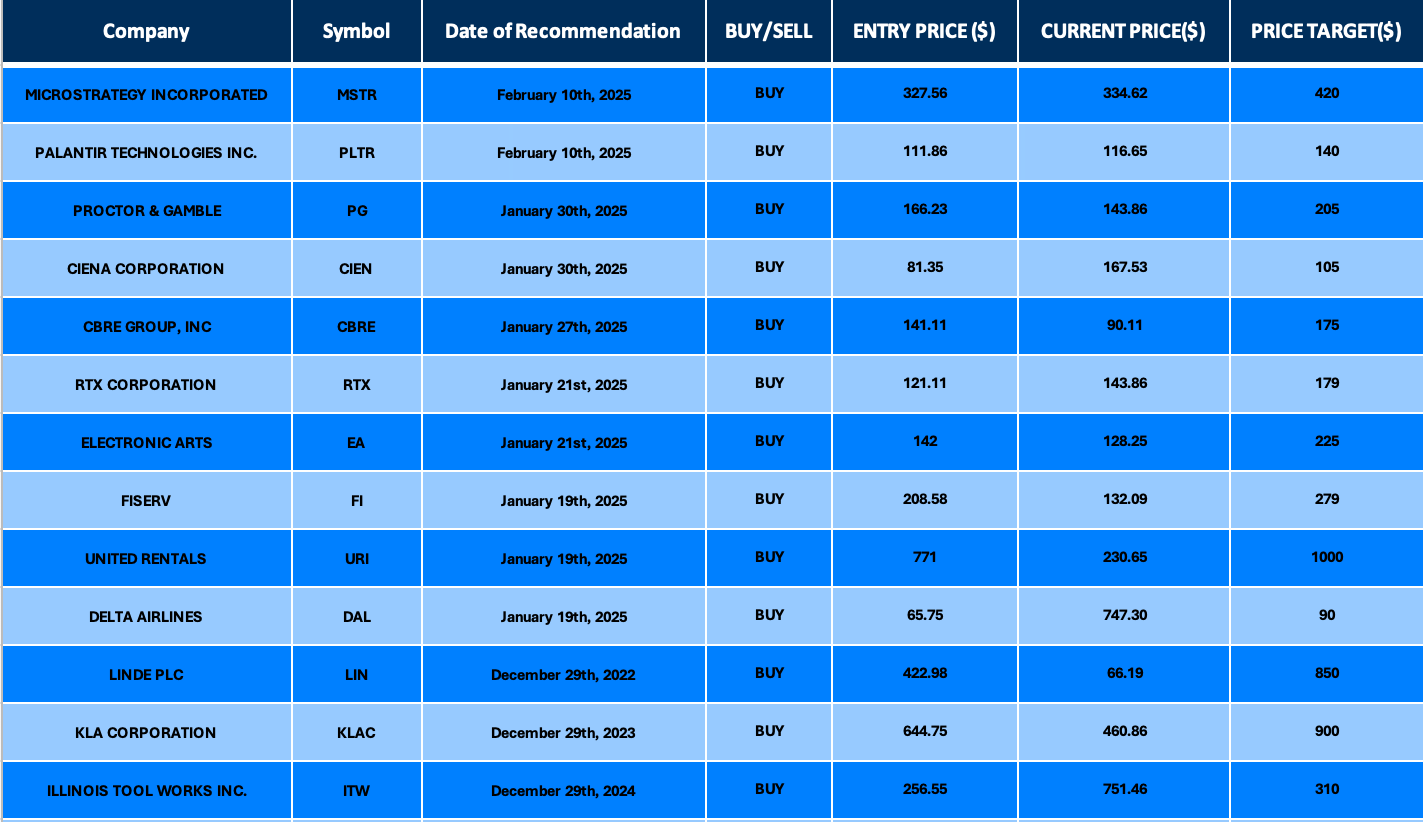
Disclaimer: This post provides financial insights for informational purposes only. It does not constitute financial advice or recommendations for investment decisions.
Daily Synopsis of the New York market close – Feb 17, 2025
Date Issued – 17th February 2025
Preview
Tencent surged to its highest since 2021 after integrating DeepSeek’s AI into WeChat, while Baidu slid nearly 9% on profit-taking. Asian central banks ramped up dollar forward contracts to defend currencies, raising concerns over deferred risks. Australian insurers, including Suncorp and IAG, plunged after opposition leader Peter Dutton threatened to break them up over premium hikes. Broadcom and TSMC are reportedly eyeing separate deals for struggling Intel, potentially splitting the chipmaker amid U.S. government scrutiny. In Japan, Q4 GDP beat forecasts with 2.8% growth, bolstering the BOJ’s rate hike trajectory despite slowing consumption and global trade uncertainties.
Tencent Shares Surge, Baidu Slides After DeepSeek’s WeChat Debut
Tencent’s stock climbed to its highest level since 2021 after integrating DeepSeek’s AI model into WeChat search, signaling strong AI adoption across Chinese tech. The Shenzhen-based giant has seen shares rise over 70% in the past year, bolstered by its gaming successes and investor optimism surrounding AI capabilities. Meanwhile, Baidu shares fell nearly 9% on profit-taking ahead of its earnings report, despite also integrating DeepSeek. Chinese equities are gaining momentum, fueled by AI advancements and renewed government support for private enterprises.
Investment Insight: Tencent’s strategic AI integration positions it as a leader in China’s tech resurgence. However, investors should monitor broader macroeconomic challenges and policy shifts to assess sustainability in the sector’s rally.
Market price: Tencent Holdings Ltd. (HKG: 0700): HKD 493.60
Rise of Dollar Forwards Builds Risk for Asian Central Banks
Asian central banks, including those in India and Indonesia, are increasingly relying on dollar forward contracts to defend their currencies against a strong dollar without depleting reserves. India’s forward position hit a record $68 billion, while Indonesia’s reached $19.6 billion, raising concerns about deferred selling pressures. While forwards offer cost advantages and avoid draining reserves, critics warn this strategy risks masking underlying vulnerabilities. Meanwhile, the Indian rupee and Indonesian rupiah remain among Asia’s weakest currencies over the past year.
Investment Insight: The growing use of forwards reflects central banks’ efforts to maintain currency stability amid dollar strength. However, investors should be cautious of hidden risks, as deferred depreciation could amplify future volatility.
Australian Insurance Stocks Slide After Opposition Leader’s Breakup Threat
Shares in Australian insurers tumbled Monday after opposition leader Peter Dutton vowed to scrutinize the sector and break up companies accused of exploiting customers if elected. Suncorp fell 21.3%, its steepest drop since 2020, while IAG and QBE also declined. Dutton’s remarks come amid mounting voter dissatisfaction with rising insurance premiums, which surged 16.4% last year, the highest in three decades. The pledge adds pressure on an industry already facing weak earnings and heightened scrutiny ahead of federal elections due by May.
Investment Insight: Political risks are rising for Australian insurers, with potential regulatory intervention looming. Investors should brace for volatility as election-driven uncertainty weighs on the sector.
Broadcom, TSMC Weigh Separate Deals for Struggling Intel
Broadcom and TSMC are exploring separate bids for Intel, potentially splitting the legacy chipmaker, according to the Wall Street Journal. TSMC is eyeing Intel’s chip plants, while Broadcom is interested in its chip-design and marketing business but may require a partner for Intel’s manufacturing arm. Talks remain in early stages, with no formal approach to Intel yet. The move comes as Intel grapples with financial losses in its foundry business and struggles to compete with rivals like Nvidia, AMD, and Qualcomm. U.S. government involvement, tied to Intel’s CHIPS Act funding, may complicate any foreign acquisition of its factories.
Investment Insight: Intel’s potential breakup signals opportunities for competitors but raises risks tied to political intervention. Investors should watch for developments in AI-driven chip demand and the fate of Intel’s leadership transition.

Japan’s Economy Outperforms Forecasts, Keeping BOJ on Track
Japan’s economy grew at an annualized 2.8% in Q4, beating the 1.1% consensus estimate and marking a third consecutive quarter of growth. Business investment and net trade drove the expansion, despite slowing private consumption and weaker imports. The data bolsters expectations that the Bank of Japan will continue gradual rate hikes, with the yen strengthening slightly after the release. Nominal GDP surpassed ¥600 trillion for the first time, though the annual growth pace for 2024 was the weakest since the pandemic.
Investment Insight: Japan’s stronger-than-expected growth supports the BOJ’s policy normalization, but slowing consumption and global trade uncertainties warrant caution. Investors should monitor the yen’s fluctuations and inflation’s impact on real wages.
Conclusion
Markets are navigating a mix of opportunities and risks, from Tencent’s AI-driven surge to Intel’s potential breakup and Japan’s robust economic growth. However, challenges persist, with political scrutiny weighing on Australian insurers, deferred risks in Asian currency interventions, and global trade uncertainties impacting Japan’s outlook. As AI advancements and macroeconomic developments shape industries, investors must remain vigilant, particularly with rising geopolitical and regulatory risks. The week ahead will likely bring further clarity on central bank policies, corporate earnings, and strategic shifts across sectors, keeping market participants poised for potential volatility and emerging opportunities.
Upcoming Dates to Watch:
- February 18th, 2025: Australia rate decision, Canada CPI
- February 19th, 2025: UK CPI
- February 21st, 2025: Japan CPI
Find below some of our Buy/Sell Recommendations. Balfour Capital Group is a distinguished global boutique investment management firm with $350 million AUM and over 1000 Clients.

Disclaimer: This post provides financial insights for informational purposes only. It does not constitute financial advice or recommendations for investment decisions.
Daily Synopsis of the New York market close – Feb 13, 2025
Date Issued – 13th February 2025
Preview
Asian markets are set for a mixed open as investors weigh optimism over US-Russia peace talks against lingering inflation concerns. Gold continues its climb toward record highs, supported by haven demand and a weaker US dollar, while Chinese tech stocks rally on AI breakthroughs, boosting the Hang Seng Tech Index. Meanwhile, the euro strengthened on renewed geopolitical hopes, and oil prices dipped as US-Russia negotiations eased supply concerns. Traders are also closely watching central bank moves, with the ECB signaling potential rate cuts this year, even as the Fed takes a more cautious approach. Key inflation data and geopolitical updates will remain in focus.
Alibaba Shares Skyrocket on AI Momentum, Reaching 2022 Highs
Alibaba’s Hong Kong-listed shares surged 46% since mid-January, adding $87 billion to its market value, fueled by renewed investor confidence in its AI ambitions. This rally outpaced the Hang Seng Tech Index and rival Chinese tech giants like Tencent and Baidu, positioning Alibaba as 2025’s top Big Tech performer in China. Optimism about its AI capabilities, including its Qwen 2.5 Max model outperforming Meta’s Llama, has been bolstered by partnerships like a rumored collaboration with Apple. Analysts see Alibaba’s AI and cloud business as key drivers for future growth, though challenges remain in monetizing AI services and competing with US cloud leaders.
Investment Insight: Alibaba’s AI-driven rebound highlights opportunities in undervalued tech stocks with strong growth prospects. Investors should monitor its cloud business expansion and AI monetization strategies, which are critical for sustaining long-term momentum.
Market price: Alibaba Group Holding Ltd. (HKG: 9988): HKD 120
ECB Signals More Rate Cuts Despite Slower Fed Moves
The European Central Bank (ECB) could enact three additional rate cuts in 2025, even if the U.S. Federal Reserve resists easing, according to Croatian policymaker Boris Vujcic. While the ECB has already cut rates five times since June, further reductions hinge on a sharp drop in core and services inflation, which Vujcic sees as critical in the coming months. Despite a weaker euro and soft economic growth in the eurozone, Vujcic expressed confidence in avoiding a recession while cautioning against expecting rapid recovery. The ECB may also revise its “restrictive” policy language as rates approach levels seen as less constraining.
Investment Insight: The ECB’s commitment to rate cuts, even amid weak growth, presents opportunities in European equities sensitive to lower borrowing costs. Investors should also watch for inflation data and potential currency impacts on trade and energy costs.
Stocks Climb, Euro Gains Amid US-Russia Peace Talks
Asian equities rallied as optimism grew over potential peace talks between the US and Russia to end the war in Ukraine, boosting global risk sentiment. European and US stock futures rose, while the euro strengthened 0.5% against the dollar as traders shifted away from haven assets. Chinese tech stocks, driven by AI developments, also contributed to the positive momentum, with the Hang Seng Tech Index nearing its highest level since the Covid-era reopening rally. Meanwhile, oil prices declined on speculation of eased risks to Russian supply, and US Treasury yields edged lower after inflation concerns tempered rate-cut expectations.
Investment Insight: Geopolitical progress, such as the US-Russia talks, can drive short-term market optimism, but inflation data and central bank policies remain critical for long-term positioning. Investors should weigh opportunities in AI-driven tech and European markets while monitoring energy price volatility.
Los Angeles Wildfires Leave Insurers Facing Billions in Losses
Insurers like AIG, Allstate, and Travelers are bracing for massive losses from the January wildfires in Los Angeles, which destroyed over 16,000 properties. AIG estimates $500 million in losses, while Travelers and Chubb project $1.7 billion and $1.5 billion, respectively. Risk modellers estimate the global insurance industry will bear $40 billion of the $250 billion in total wildfire-related losses. Insurers had already scaled back their California operations due to rising natural disaster risks and stringent consumer protection laws, leaving many residents vulnerable as premiums failed to keep pace with inflation.
Investment Insight: The escalating frequency and intensity of natural disasters, paired with regulatory challenges, are forcing insurers to reassess market exposure and risk-adjusted returns. Investors in the insurance sector should monitor shifts toward higher premiums and increasing reliance on non-admitted markets for profitability.

Gold Nears Record High Amid Dollar Weakness and Geopolitical Focus
Gold climbed to $2,917 an ounce, approaching its all-time high of $2,942, as the US dollar weakened and Treasury yields fell. The metal’s ascent was supported by haven demand, optimism surrounding US-Russia peace talks on Ukraine, and central bank purchases, including from China. Traders are also monitoring President Donald Trump’s trade policies and lingering inflation concerns, which weakened the case for US rate cuts. Spot gold has gained over 11% this year, with momentum building toward a potential test of $3,000 an ounce.
Investment Insight: Gold’s rally underscores its role as a hedge against geopolitical risks and currency volatility. Investors should consider gold-backed ETFs and related assets as central bank buying and haven demand continue to drive prices higher.
Conclusion
Markets are navigating a complex mix of geopolitical optimism, inflation pressures, and central bank signals. The US-Russia peace talks have buoyed risk sentiment, lifting equities and weakening the dollar, while gold edges closer to record highs as a safe-haven asset. Chinese tech stocks continue to shine on AI momentum, adding strength to Asian markets. However, concerns over inflation and the Fed’s cautious stance on rate cuts remain key factors for investors. As the day unfolds, market participants will stay focused on geopolitical developments, central bank commentary, and economic data to guide their next moves. Stay tuned for further updates.
Upcoming Dates to Watch:
- February 13th, 2025: German CPI, Eurozone Industrial Production
- February 14th, 2025: Eurozone GDP
Find below some of our Buy/Sell Recommendations. Balfour Capital Group is a distinguished global boutique investment management firm with $350 million AUM and over 1000 Clients.

Disclaimer: This post provides financial insights for informational purposes only. It does not constitute financial advice or recommendations for investment decisions.
Daily Synopsis of the New York market close – Feb 12, 2025
Date Issued – 12th February 2025
Preview
Hon Hai (Foxconn) signaled interest in Renault’s 36% stake in Nissan, aiming to expand its EV ambitions, though risks to Nissan’s independence remain. Bond yields rose as Fed Chair Jerome Powell urged patience on rate cuts ahead of key US CPI data, while Hong Kong stocks rallied on Alibaba’s AI partnership with Apple. Super Micro (SMCI) shares swung as it pledged to meet SEC filing deadlines amid legal scrutiny and cut fiscal 2025 guidance. Commerzbank plans 3,000-4,000 job cuts and a strategy update to fend off UniCredit’s takeover bid, despite investor intrigue in the potential tie-up. Lastly, President Trump’s proposed reciprocal tariffs could raise costs for U.S. consumers, spark global retaliation, and disrupt trade-dependent sectors, adding to inflationary risks.
Hon Hai Open to Buying Renault’s Stake in Nissan
Hon Hai Precision Industry Co. (Foxconn), Apple’s largest production partner, has signaled interest in acquiring Renault SA’s 36% stake in Nissan Motor Co. This potential move comes as Nissan faces ongoing struggles, including outdated car models and leadership instability. Hon Hai Chairman Young Liu clarified that the company’s aim is cooperation, not ownership, as it explores partnerships with Nissan and Honda to expand into electric vehicles (EVs) and diversify beyond its core electronics business. Nissan’s shares briefly recovered before resuming their decline, reflecting investor uncertainty.
Investment Insight: Hon Hai’s potential stake in Nissan could enhance its EV ambitions but carries risks of diluting Nissan’s independence. Investors should monitor how this impacts Nissan’s restructuring and Hon Hai’s diversification strategy in a competitive EV market.
Market price: Hon Hai Precision Industry Co Ltd. (TPE:2317): TWD 177.00
Bonds Decline After Powell, Hong Kong Stocks Surge
Bond yields rose as Federal Reserve Chair Jerome Powell signaled patience before cutting rates further, with markets awaiting key US CPI data. US equity futures dipped, while Hong Kong stocks rallied, driven by an 8.6% surge in Alibaba on AI collaboration news with Apple and record gains in BYD, fueled by optimism over its smart-driving strategy. Japanese 5-year bond yields hit 1% for the first time since 2008, while the yen extended its decline amid tariff concerns.
Investment Insight: The Fed’s cautious approach to rate cuts reflects persistent inflation risks. Investors should closely watch CPI data, as stronger-than-expected prints could pressure bonds further. Meanwhile, AI-driven optimism in Chinese equities highlights growth potential in tech and EV sectors.

Super Micro Stock Swings on Filing Deadline and Earnings Miss
Super Micro Computer (SMCI) shares seesawed as the server maker assured investors it would meet Nasdaq’s Feb. 25 deadline for delayed SEC filings to avoid delisting. The filings were postponed after a short-seller report accused the company of accounting violations, triggering a DOJ probe. Preliminary Q2 earnings missed Wall Street estimates, with revenue guidance for fiscal 2025 cut sharply. Shares plunged 19% after the update but rebounded more than 3% in after-hours trading.
Investment Insight: Super Micro’s volatile stock reflects uncertainty from ongoing legal and regulatory issues. While the company remains confident in its compliance, cautious investors should watch for further developments around its filings and fiscal guidance.
Market price: Super Micro Computer (SMCI): USD 38.61
Commerzbank Plans Job Cuts, Strategy Update to Fend Off UniCredit
Commerzbank is planning to cut 3,000-4,000 jobs and set new financial targets in a bid to thwart takeover efforts by Italy’s UniCredit. The German lender, which is partially state-owned, aims to highlight its potential as an independent entity through a strategy update to be unveiled Thursday. The plans include cost reductions, streamlined operations via technology, and potential smaller acquisitions. Despite political resistance to UniCredit’s advances, Commerzbank’s stock has surged 50% since the Italian bank declared interest, underscoring investor intrigue in the potential tie-up.
Investment Insight: Commerzbank’s push for independence may reassure investors in the short term, but UniCredit’s persistent interest and political hurdles expose long-term uncertainties. Investors should monitor the strategy update and its impact on operational efficiency and profitability.
Trump Pushes Matching Tariffs, Risking Global Trade Showdown
President Donald Trump is set to sign an order imposing tariffs on imports that match tax rates charged by trading partners, aiming for “reciprocity.” This move could sharply increase costs for U.S. consumers and businesses, with retaliatory measures from partners like the EU, Canada, and Mexico threatening global economic stability. The sweeping tariffs, targeting goods like autos, computer chips, and pharmaceuticals, mark a break from past U.S. trade policies. While Trump argues tariffs will boost the economy, critics warn of inflation and disrupted supply chains.
Investment Insight: Trump’s tariff strategy may accelerate inflation and weigh on corporate margins. Investors should prepare for heightened market volatility, particularly in sectors reliant on global trade, such as manufacturing, tech, and consumer goods.
Conclusion
Hon Hai (Foxconn) signaled interest in Renault’s 36% stake in Nissan, aiming to expand its EV ambitions, though risks to Nissan’s independence remain. Bond yields rose as Fed Chair Jerome Powell urged patience on rate cuts ahead of key US CPI data, while Hong Kong stocks rallied on Alibaba’s AI partnership with Apple. Super Micro (SMCI) shares swung as it pledged to meet SEC filing deadlines amid legal scrutiny and cut fiscal 2025 guidance. Commerzbank plans 3,000-4,000 job cuts and a strategy update to fend off UniCredit’s takeover bid, despite investor intrigue in the potential tie-up. Lastly, President Trump’s proposed reciprocal tariffs could raise costs for U.S. consumers, spark global retaliation, and disrupt trade-dependent sectors, adding to inflationary risks.
Upcoming Dates to Watch:
- February 12th, 2025: US CPI; India CPI, Industrial Production
- February 13th, 2025: German CPI, Eurozone Industrial Production
- February 14th, 2025: Eurozone GDP
Find below some of our Buy/Sell Recommendations. Balfour Capital Group is a distinguished global boutique investment management firm with $350 million AUM and over 1000 Clients.

Disclaimer: This post provides financial insights for informational purposes only. It does not constitute financial advice or recommendations for investment decisions.
Daily Synopsis of the New York market close – Feb 11, 2025
Date Issued – 11th February 2025
Market Overview
Markets saw significant moves this week, starting with US Steel shares surging 6% on Trump’s proposed 25% steel tariffs, boosting domestic producers but raising concerns for industries reliant on steel. India’s rupee rallied nearly 1%, marking its biggest jump in two years, following heavy suspected intervention by the Reserve Bank of India to stabilize the currency. Meanwhile, gold hit record highs near $2,950/oz as trade war fears and geopolitical tensions over Trump’s ultimatum to Hamas drove safe-haven demand. UK savers turned to gilts for tax-free gains, with rising purchases fueled by high yields and economic uncertainty. Finally, Foxconn shares climbed 3% on strong January sales, driven by AI server demand, though challenges in consumer electronics remain.
US Steel Surges on Trump Tariff Plan
US Steel shares jumped 6% Monday after former President Donald Trump proposed a 25% tariff on steel imports. The announcement, expected to be formalized soon, boosted US metals producers like Nucor (+7%), Cleveland-Cliffs (+15%), and Steel Dynamics (+6%). The tariffs aim to curb cheaper foreign steel imports, granting domestic producers pricing power and higher profit potential. While the policy may hurt Canada, Brazil, and Mexico—America’s top steel suppliers—it is expected to have limited impact on China, which ranks lower as a supplier.
Investment Insight: Tariff-driven price hikes could bolster US steelmakers’ margins, but higher costs for key inputs may weigh on industries reliant on steel, like automotive and construction. Diversify exposure to mitigate sector-specific risks.
Market Price: United States Steel Corp (NYSE: X): USD 38.70
Rupee’s Biggest Surge in Two Years Shocks Markets
India’s rupee rallied nearly 1% on Tuesday, marking its largest single-day gain since November 2022. The unexpected surge, attributed to suspected heavy intervention by the Reserve Bank of India (RBI), halted a streak of record lows against the dollar. Traders speculate the RBI sold as much as $11 billion over two days to stabilize the currency. This comes after recent depreciation fueled by rate cuts and a stronger dollar linked to US tariff moves. Analysts see the intervention as a strategic move to curb speculative pressure while maintaining market stability under Governor Sanjay Malhotra.
Investment Insight: Currency stabilization efforts could temporarily boost investor confidence in Indian assets. However, sustained intervention may deplete reserves. Monitor RBI’s policy tone and dollar strength for emerging market exposure.

Gold Hits Record High Near $2,950 Amid Trade and Geopolitical Jitters
Gold prices soared to all-time highs in Asian trading, with spot gold reaching $2,942.69/oz and futures peaking at $2,968.39/oz. Safe-haven demand surged as U.S. President Donald Trump imposed 25% tariffs on steel and aluminum imports, with threats of further trade duties sparking fears of a global trade war. Market anxiety was further amplified by Trump’s ultimatum to Hamas over Israeli hostages, intensifying geopolitical tensions in the Middle East. While gold rallied, other metals like silver (-0.5%) and copper (-0.6%) declined as a strong dollar weighed on industrial commodities.
Investment Insight: Gold’s record surge underscores its role as a hedge against economic and geopolitical uncertainty. Investors should monitor inflation trends and central bank policy, as prolonged tensions could sustain gold’s upward momentum.
Savers Flock to Gilts for Tax-Free Gains Amid Economic Uncertainty
Savers are increasingly turning to UK government bonds (gilts) to avoid capital gains tax and secure steady returns. Gilts offer tax-free gains on redemption or sale below the purchase price, making them attractive amid frozen income tax thresholds and reduced personal savings allowances. Wealth managers report a surge in gilt purchases, driven by high yields, predictable returns, and economic concerns. Short-dated, low-coupon gilts are particularly popular for their tax efficiency and guaranteed capital growth, providing a stable option in uncertain times.
Investment Insight: Rising gilt allocations highlight a shift toward tax-efficient, low-risk strategies. Investors seeking stability and predictable returns should consider gilts, especially in a high-tax environment, but remain mindful of inflation risks impacting real yields.
Foxconn Shares Rise on Strong January Sales and AI Demand
Foxconn, a key Nvidia supplier, saw its shares climb nearly 3% on Tuesday after reporting January revenues of NT$538.67 billion ($16.42 billion), up 3.2% year-on-year. Growth was driven by robust demand for AI servers and cloud products, bolstering optimism despite entering a traditionally weaker sales period. Foxconn’s diversification into AI infrastructure has been a key driver of its recent success, though slower consumer electronics sales, including iPhones for Apple, remain a challenge. The company is also expanding into electric vehicles, with potential investments in Nissan.
Investment Insight: Foxconn’s focus on AI and diversification into EVs positions it well for long-term growth. However, its reliance on consumer electronics could weigh on performance. Investors should watch its AI-related ventures and EV developments for sustained momentum.
Market Price: Hon Hai Precision Industry Co Ltd. (TPE:2317): TWD 179.00
Conclusion
This week’s market movements highlight the interplay between policy, geopolitics, and shifting investor strategies. From Trump’s tariffs driving steel stocks and gold to new highs, to India’s rupee rallying on central bank intervention, macroeconomic forces remain in sharp focus. Savers are seeking refuge in tax-efficient gilts, while Foxconn’s AI-driven growth offers a glimpse into tech’s resilience amid weaker consumer electronics demand. As markets navigate uncertainty, diversification and a keen eye on inflation, interest rates, and geopolitical developments will be key to staying ahead. Stay tuned for more insights as these stories continue to evolve.
Upcoming Dates to Watch
- February 11th, 2025: Brazil CPI
- February 12th, 2025: US CPI; India CPI, Industrial Production
- February 13th, 2025: German CPI, Eurozone Industrial Production
- February 14th, 2025: Eurozone GDP
Find below some of our Buy/Sell Recommendations. Balfour Capital Group is a distinguished global boutique investment management firm with $350 million AUM and over 1000 Clients.

Disclaimer: This post provides financial insights for informational purposes only. It does not constitute financial advice or recommendations for investment decisions.
Daily Synopsis of the New York market close – Feb 10, 2025
Date Issued – 10th February 2025
Preview
China has launched a pilot program allowing insurers to invest in gold for the first time, unlocking up to $27.4 billion in potential demand. Separately, the country will transition to market-based pricing for renewable energy by year-end, moving its maturing clean energy sector away from subsidies. Taiwan Semiconductor Manufacturing Co. (TSMC) reported slowing sales growth amid AI market shifts and geopolitical risks but plans record $42 billion capital expenditures in 2025. Meanwhile, President Trump’s proposed 25% tariffs on steel and aluminum imports drove the dollar higher and Asian stocks lower, fueling trade tensions. In AI, OpenAI CEO Sam Altman predicts usage costs will drop 10x annually, driving exponential adoption. Tech giants like Amazon and Microsoft plan to ramp up AI investments, with combined capex surpassing $320 billion this year. Markets remain focused on monetary policy signals, inflation data, and geopolitical developments for clarity on long-term impacts.
China Opens $27 Billion Opportunity for Gold Investment
China has launched a pilot program allowing insurers to invest in gold for the first time, potentially unlocking $27.4 billion in funds. Ten major firms, including PICC Property & Casualty Co. and China Life Insurance Co., can allocate up to 1% of their assets to bullion. This marks a significant policy shift as authorities seek alternatives to traditional investment options amid a property slump and economic slowdown. Gold, which has surged 40% since late 2023, continues to rally on economic and geopolitical risks.
Investment Insight
Gold’s inclusion in Chinese insurers’ portfolios signals increased institutional demand, reinforcing its safe-haven appeal. However, investors should watch for potential volatility as prices may already reflect heightened interest.
China Moves to Market-Based Pricing for Clean Energy
China is set to end fixed pricing for renewable energy, allowing market forces to determine electricity costs. Local governments will implement the new pricing system by year-end, with safeguards like balancing payments to limit price volatility. Wind and solar projects installed before June 1, 2025, will retain existing compensation rules, while newer projects face less favorable terms. This transition reflects China’s effort to move its maturing renewable energy sector away from subsidies while managing economic pressures.
Investment Insight
Market-based pricing could improve efficiency in China’s renewable sector but may pressure profit margins for new projects. Investors should monitor how balancing payments and local policies evolve, especially for post-June installations.

TSMC Sales Growth Slows Amid AI Market Shifts
Taiwan Semiconductor Manufacturing Co. (TSMC) reported a 36% revenue increase in January to NT$293.3 billion ($8.9 billion), down from 38.8% growth in Q4 2024. Analysts had expected a 41% rise for the current quarter. The slowdown comes as Nvidia’s primary chip supplier faces uncertainty in AI spending, driven by competition from Chinese startup DeepSeek. Meanwhile, TSMC plans record capital expenditures of $42 billion in 2025, despite potential US tariffs on semiconductor imports.
Investment Insight
While AI demand remains robust, rising competition and geopolitical tensions pose risks to TSMC’s growth. Investors should monitor capital expenditure execution and US policy developments for mid-term impacts.
Market Price: Taiwan Semiconductor Manufacturing Co. Ltd. (TPE:2330): TWD 1,105.00
Dollar Rises, Asian Stocks Drop on Trump Tariffs
President Donald Trump’s plan to impose a 25% tariff on all steel and aluminum imports sent the dollar higher and Asian stocks lower, with the benchmark for regional shares experiencing its biggest drop in a week. The greenback gained against major currencies as markets speculated on rising inflation and limited Federal Reserve rate cuts. Meanwhile, US and European stock futures showed modest gains, as investors anticipated Fed Chair Jerome Powell’s testimony and key US inflation data this week.
Hong Kong stocks bucked the trend, with the Hang Seng Tech Index climbing to its highest level since October, driven by optimism over China’s AI advancements. Commodities markets remained muted, while US Treasury yields edged lower.
Investment Insight
Rising tariffs heighten global trade tensions, creating short-term volatility in equities and commodities. Investors should focus on Fed policy signals and inflation data for guidance on the broader impact of protectionist moves.
Sam Altman Predicts 10x Annual Drop in AI Costs
OpenAI CEO Sam Altman stated in a blog post that the cost of using AI will drop 10 times annually, driving exponential adoption. Highlighting a 150x price-per-token reduction from GPT-4 in 2023 to GPT-4o in 2024, Altman compared this trend to Moore’s Law but noted it is “unbelievably stronger.” He also emphasized that AI intelligence scales predictably with investment, suggesting no near-term limits to exponential growth. Altman predicts dramatic economic shifts, including falling costs for many goods and rising prices for limited resources like land.
The post comes as tech giants like Amazon, Microsoft, and Meta ramp up AI investments, with combined capex exceeding $320 billion in 2025, and following the launch of Stargate, a $500 billion US-led AI infrastructure project.
Investment Insight
Plummeting AI costs could disrupt industries, creating opportunities in software and services while pressuring hardware suppliers. Investors should focus on emerging AI applications and infrastructure initiatives like Stargate for long-term growth potential.
Conclusion
From China’s $27 billion gold investment opportunity to its market-based clean energy shift, the week highlights the nation’s evolving economic strategies. TSMC’s slowing sales growth reflects growing competition in AI, while Trump’s proposed tariffs fuel global trade tensions and market volatility. Amid this, OpenAI’s Sam Altman predicts plummeting AI costs, signaling transformative impacts across industries as tech giants ramp up investments. As geopolitical shifts and monetary policy remain in focus, investors should stay attuned to inflation data, US-China dynamics, and the AI sector’s rapid evolution for both risks and opportunities in the months ahead.
Upcoming Dates to Watch
- February 10th, 2025: China retaliatory tariffs on US to take effect
- February 11th, 2025: Brazil CPI
- February 12th, 2025: US CPI; India CPI, Industrial Production
- February 13th, 2025: German CPI, Eurozone Industrial Production
- February 14th, 2025: Eurozone GDP
Find below some of our Buy/Sell Recommendations. Balfour Capital Group is a distinguished global boutique investment management firm with $350 million AUM and over 1000 Clients.
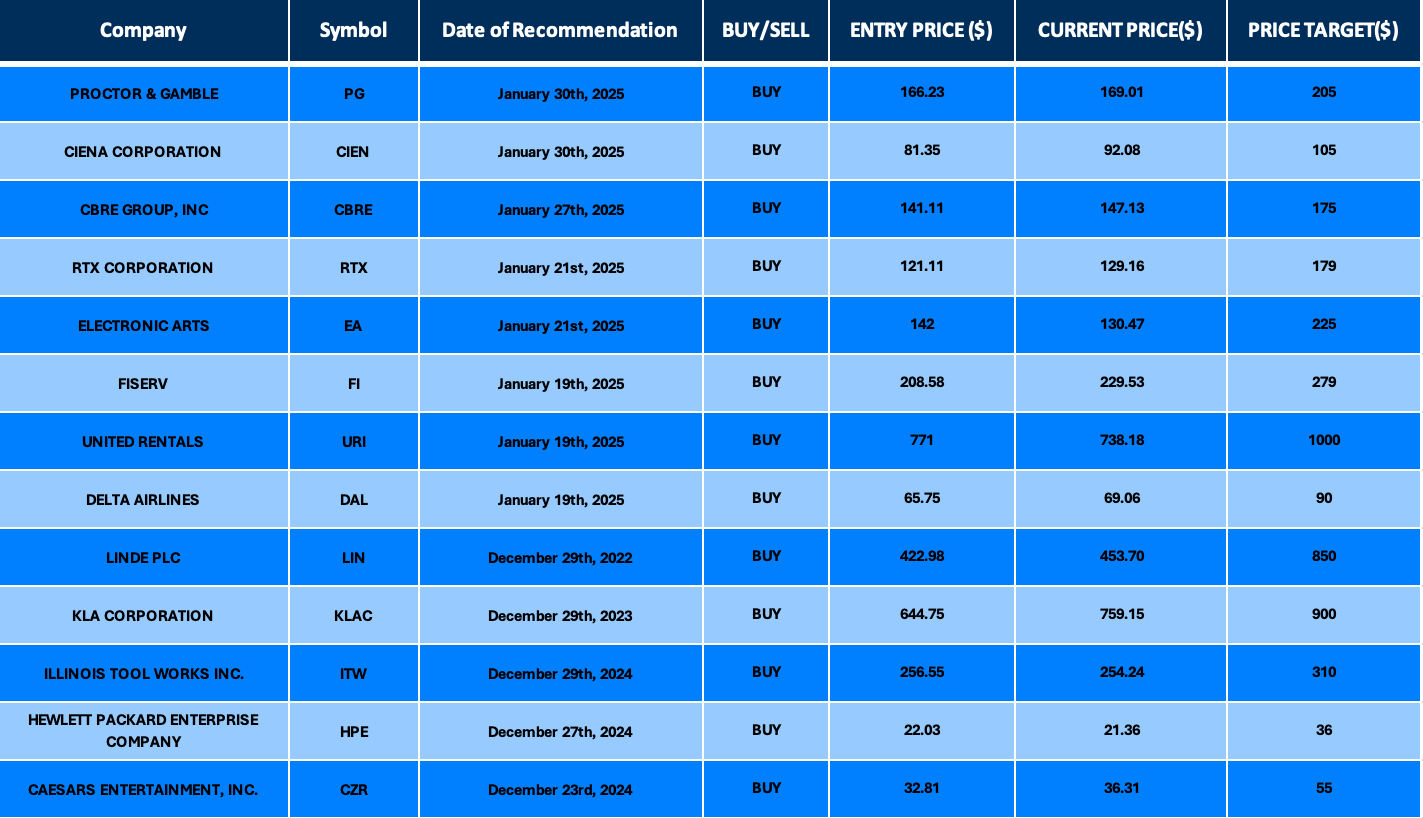
Disclaimer: This post provides financial insights for informational purposes only. It does not constitute financial advice or recommendations for investment decisions.
Daily Synopsis of the New York market close – Feb 7, 2025
Date Issued – 7th February 2025
China’s Private Oil Refiners and Global Market Impacts
China’s private oil refiners, or “teapots,” have cut operating rates to 43.64%, the lowest since March 2020, as U.S. sanctions on Russian oil disrupt supply chains and force reliance on costlier alternatives. Meanwhile, Hong Kong faces mounting risks as U.S. tariffs now treat the city like mainland China, eroding its appeal to international investors. In the U.S., January job growth is expected to slow to 170,000, with disruptions and revisions adding uncertainty. Chinese tech stocks rallied, pushing the Hang Seng Tech Index into a bull market, while Xiaomi hit a record high, fueled by subsidies, new product launches, and AI momentum.
Moderate U.S. Job Growth Expected Amid January Data Distortions
U.S. job growth likely slowed in January, with economists forecasting a gain of 170,000 jobs, down from December’s 256,000 surge. The slowdown reflects temporary disruptions from California wildfires and severe winter weather, as well as annual revisions to employment data. The unemployment rate is expected to hold steady at 4.1%, with wage growth remaining solid at 0.3% for the month. However, economists warn that job growth is increasingly concentrated in lower-paying industries, masking potential white-collar job losses.
Investment Insight: Labor market resilience supports the Federal Reserve’s pause on rate cuts, but investors should be cautious of slower employment momentum and policy-related uncertainties in early 2025.
China’s Oil Teapots Cut Runs to Pandemic Levels Amid Sanctions
Chinese private oil processors, known as “teapots,” have reduced operating rates to just 43.64%, the lowest since March 2020. The drop follows U.S. sanctions on Russian oil that have severely limited access to the preferred ESPO crude grade. The sanctions, imposed last month, disrupted supply chains and increased reliance on more expensive alternatives like Oman and Abu Dhabi crude.
Refiners in Shandong province, already grappling with a sluggish economy and weak fuel demand, are now facing mounting losses—over 150 yuan per ton compared to 300 yuan in profits a year ago. The disruption has also impacted refiners across Asia, where rising freight costs and tighter supply add to the strain.
Investment Insight: China’s teapots, a key player in the global oil market, are under unprecedented pressure. The sanctions not only highlight vulnerabilities in the supply chain but could also ripple through broader energy markets as refiners cut operations further.

Hong Kong Caught in Trump’s Trade War With China
Hong Kong’s global financial hub status faces fresh pressure as Donald Trump’s new trade war policies equate the city with mainland China. A 10% tariff on Chinese goods now includes Hong Kong, following the 2020 removal of its special privileges. The move underscores growing geopolitical risks for businesses operating in the city, as U.S. actions blur distinctions between Hong Kong and Beijing. Economists expect minimal direct economic impact from the tariffs, but the broader implications of diminished autonomy could deter international investment and further erode the city’s image.
Investment Insight: Businesses with ties to Hong Kong face escalating political risks, particularly in regions where the U.S. and China compete for influence. Investors should closely monitor geopolitical developments as Hong Kong’s unique status diminishes.
China Lifts Asian Stocks as Markets Await U.S. Jobs Data
Chinese tech stocks rallied Friday, propelling Hong Kong’s Hang Seng Index to its highest since November, while the Hang Seng Tech Index entered a technical bull market with a 20% gain since January. Mainland Chinese and Taiwanese stocks also advanced, offsetting declines in Japan and South Korea. Traders are now focused on U.S. nonfarm payroll data, expected to show 175,000 new jobs, which will shape expectations for Federal Reserve rate cuts. A weak jobs number could fuel rate-cut hopes, while a stronger figure may delay monetary easing.
Investment Insight: Chinese tech stocks show renewed momentum, driven by AI developments. Investors should monitor U.S. jobs data closely as it may impact global rate expectations and market volatility.
Xiaomi Hits Record High on China’s Subsidy Program
Xiaomi Corp. shares hit a record high in Hong Kong, surging 12% this week, fueled by China’s consumer subsidy program and upcoming launches of the SU7 Ultra EV and 15 Ultra smartphone. Analysts raised shipment forecasts, citing subsidies for wearables and falling AI costs after DeepSeek’s latest model launch. Xiaomi’s strong 2024 performance, driven by its EV entry and AIoT platform, positions it for continued growth in 2025 as factory capacity expands.
Investment Insight: Xiaomi’s record-breaking rally highlights its strength in leveraging subsidies and AI advancements. Investors should watch for further gains tied to its diversified product strategy and Chinese tech’s bull market momentum.
Conclusion
Global markets face heightened uncertainty as geopolitical tensions, economic slowdowns, and shifting policies weigh on key players. China’s oil teapots struggle under U.S. sanctions, while Hong Kong’s diminishing autonomy raises risks for investors. Slower U.S. job growth adds to concerns, though solid wage gains suggest resilience. On a brighter note, Chinese tech stocks and Xiaomi’s record-breaking rally highlight opportunities in AI and consumer-driven innovation. As markets navigate these mixed signals, investors should remain vigilant, balancing near-term risks with long-term growth potentials, particularly in tech and energy sectors. Global trends demand a close watch on evolving policies and market drivers.
Upcoming Dates to Watch
- February 7th, 2025: US nonfarm payrolls, unemployment; Canada unemployment
Find below some of our Buy/Sell Recommendations. Balfour Capital Group is a distinguished global boutique investment management firm with $350 million AUM and over 1000 Clients.

Disclaimer: This post provides financial insights for informational purposes only. It does not constitute financial advice or recommendations for investment decisions.
Daily Synopsis of the New York market close – Feb 6, 2025
Date Issued – 6th February 2025
Preview
Mitsubishi UFJ Financial Group (MUFG) is set to achieve record profits of ¥1.75 trillion ($11 billion) this fiscal year, driven by rising domestic rates, strong markets, and a weak yen. Despite a 39% surge in shares, CFO Jun Togawa stresses sustainable growth through fee revenue, fintech in Asia, and cost control, aiming for a higher price-to-book ratio and global competitiveness.
Meanwhile, Alphabet’s $75 billion AI-driven capex plan for 2025 has fueled a semiconductor rally, benefitting Nvidia, Broadcom, and others. Amazon’s earnings on Thursday will offer clues on retail trends amid strong consumer spending but lingering risks like tariffs. China’s tungsten export controls are stoking supply fears, with Almonty Industries seeing surging demand as it expands outside China. Lastly, the Bank of England is expected to cut rates to 4.50% amid economic stagnation, signaling concerns but offering relief to rate-sensitive sectors. Across industries, opportunities coexist with geopolitical, economic, and market risks, demanding careful investor navigation.
MUFG Eyes Sustainable Growth Beyond Record Profits
Mitsubishi UFJ Financial Group (MUFG) is on track to achieve a record ¥1.75 trillion ($11 billion) in net income for the year ending March, bolstered by rising domestic interest rates, a buoyant stock market, and a weak yen. Shares have surged 39% over the past year, making MUFG Japan’s second most valuable company by market cap after Toyota.
However, CFO Jun Togawa emphasizes the need for sustainable growth through fee revenue expansion, fintech investments in Asia, and improved cost control. MUFG is also targeting a higher price-to-book ratio to compete globally and attract international investors, supported by ongoing share buyback programs.
Investment Insight
MUFG’s focus on fee-based revenue and fintech investments signals long-term growth potential. Its undervalued shares and shareholder-friendly buybacks may appeal to investors seeking exposure to Japan’s financial sector recovery.
Market price: MUFG Financial Group Inc (TYO: 8306): JPY 1,952
Google’s AI Spending Spurs Chip Stock Surge
Alphabet’s announcement of a $75 billion capital expenditure plan for 2025—up sharply from $52 billion last year—has sparked optimism across the chip sector. Nvidia, Broadcom, and other semiconductor stocks rallied on Wednesday, buoyed by expectations that Google’s AI ambitions will drive robust demand for cutting-edge chips.
Alphabet’s spending plans come amid a broader wave of AI investment, with Meta, Microsoft, and Tesla also committing to increased capex for AI development. Despite a 7% drop in Alphabet’s stock, Nvidia climbed nearly 5%, Broadcom surged 6%, and other chipmakers, including TSMC and Micron, saw gains.
Investment Insight
The AI arms race among tech giants promises sustained demand for advanced semiconductors. Investors should monitor chipmakers with strong ties to AI-focused firms, as this trend could fuel long-term growth opportunities.

Amazon Earnings Could Set Tone for Retailers in 2025
Amazon will kick off major retailers’ earnings season on Thursday, offering insights into consumer spending after a record-breaking holiday season. Analysts predict strong sales growth for Amazon, Walmart, Costco, and Target this year, driven by rising consumer spending, moderated inflation, and stable job markets. Amazon is expected to report a 10% year-over-year increase in goods sold, while Walmart and Costco benefit from value-focused shoppers.
However, risks such as tariffs and a potential stock market correction could dampen momentum, with analysts warning these factors may halve consumer spending growth in 2025.
Investment Insight
Retailers with strong e-commerce platforms and value-driven strategies—like Amazon and Costco—are well-positioned for growth. However, investors should remain cautious of macroeconomic risks like tariffs and market volatility that could impact consumer spending trends.
China’s Tungsten Export Controls Spark Supply Fears
China’s recent export controls on tungsten, a critical metal for defense and high-tech industries, have sent shockwaves through global markets. Almonty Industries, a major North American tungsten miner, reports surging inquiries as customers grapple with potential supply shortages. China produces 80% of the world’s tungsten, and additional restrictions could further tighten availability.
Almonty’s stock has surged 41% in two days, reflecting investor concerns over the scarcity of the material, used in munitions, engine parts, and semiconductors. Almonty is expanding operations in South Korea to reduce reliance on Chinese output, with a new mine set to open in two months.
Investment Insight
China’s dominance in tungsten supply underscores geopolitical risks in critical minerals. Investors may consider companies like Almonty, which are diversifying production outside of China, as strategic plays in an increasingly constrained market.
Bank of England Poised for Third Rate Cut
The Bank of England is expected to cut its key interest rate to 4.50% on Thursday, marking its third reduction in six months. While inflation remains slightly above the 2% target at 2.5%, a stagnating economy and declining employment are pushing policymakers toward more urgent action.
The move comes as inflationary pressures ease, particularly in the services sector, despite looming business tax hikes from the Labour government. Markets will closely watch Governor Andrew Bailey’s tone and the bank’s updated economic forecasts for clues on future monetary policy.
Investment Insight
Lower rates could ease borrowing costs but signal deeper concerns about the U.K.’s economic outlook. Investors should assess potential headwinds for banks and opportunities in rate-sensitive sectors like housing and consumer goods.
Conclusion
In a rapidly shifting global landscape, opportunities and risks are emerging across industries. MUFG’s push for sustainable growth highlights the evolving dynamics of Japan’s financial sector, while Alphabet’s AI investments signal long-term demand for advanced semiconductors. Retail giants like Amazon are poised for solid performance, though macroeconomic risks cast a shadow over consumer spending. China’s tungsten export controls underscore the fragility of critical supply chains, pushing diversification efforts. Meanwhile, the Bank of England’s expected rate cut reflects mounting economic pressures.
For investors, strategic positioning in growth sectors and vigilance toward geopolitical and economic headwinds will be key to navigating 2025.
Upcoming Dates to Watch
- February 6th, 2025: UK rate decision, Amazon earnings
- February 7th, 2025: US nonfarm payrolls, unemployment; Canada unemployment
Find below some of our Buy/Sell Recommendations. Balfour Capital Group is a distinguished global boutique investment management firm with $350 million AUM and over 1000 Clients.
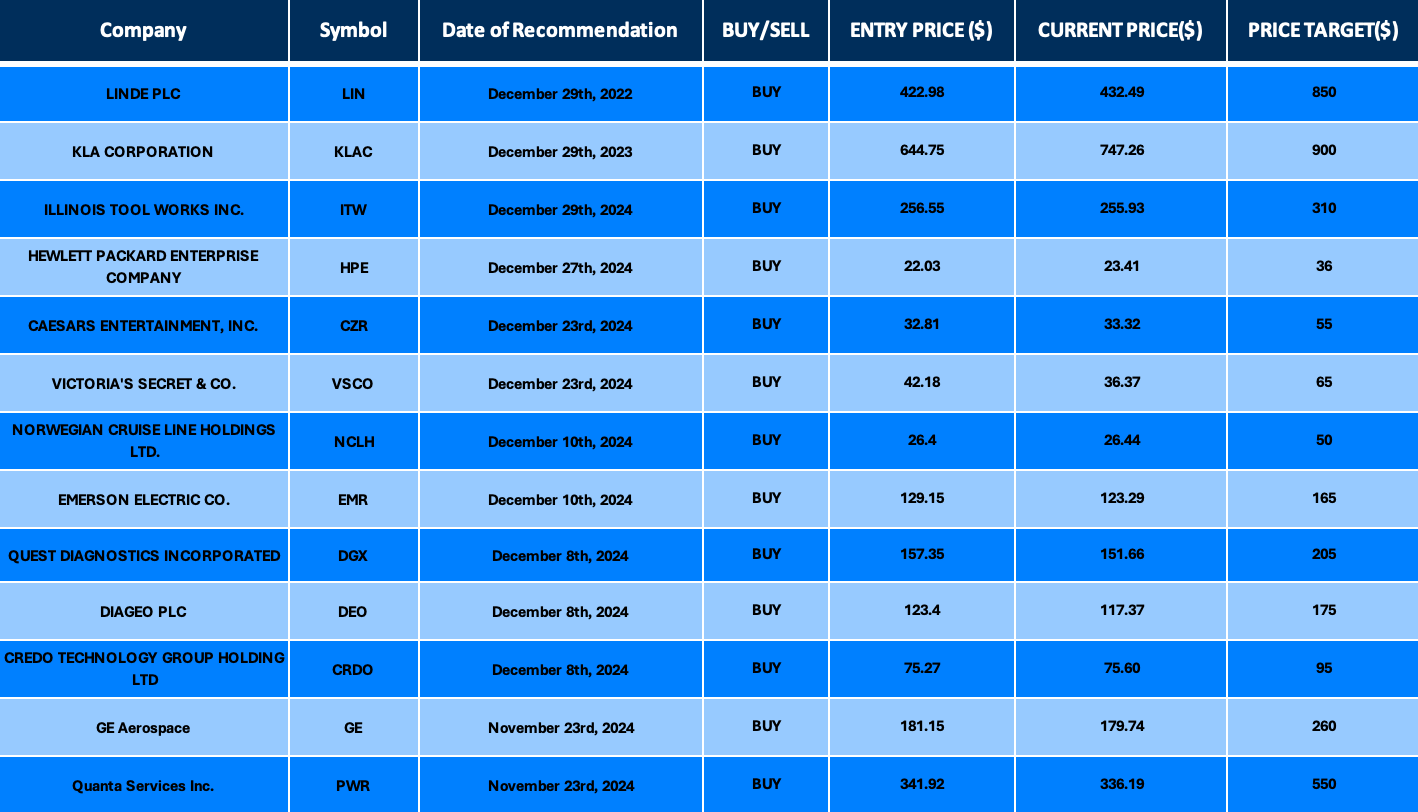
Disclaimer: This post provides financial insights for informational purposes only. It does not constitute financial advice or recommendations for investment decisions.
Daily Synopsis of the New York market close – Feb 5, 2025
Date Issued – 5th February 2025
Preview
Toyota is expanding its EV operations in China with a new Shanghai unit set to produce 100,000 Lexus vehicles annually by 2027 while raising its profit forecast to ¥4.7 trillion ($30.7 billion) despite a quarterly earnings dip. Meanwhile, Trump’s revocation of the de minimis rule and new 10% tariffs on Chinese imports are raising costs for e-commerce giants like Shein and Temu, spurring legal challenges and market shifts. Asian stocks slid after weak Chinese manufacturing data and escalating US-China trade tensions, with gold hitting a record high. The USPS also suspended parcels from China and Hong Kong, further straining supply chains. Lastly, California’s wildfires underscore the state’s insurance crisis, as reliance on the underfunded FAIR Plan grows amid private insurer pullbacks. Elevated risks persist across trade, insurance, and commodity markets.
Toyota Expands in China and Raises Profit Forecast
Toyota Motor is establishing a wholly owned unit in Shanghai to develop and produce electric vehicles and batteries for its Lexus brand, with production beginning in 2027. The unit aims to produce 100,000 vehicles annually and create 1,000 jobs in its initial phase. Toyota will also partner with the Shanghai municipal government on carbon-neutral initiatives, aligning with China’s 2060 carbon neutrality goal.
Meanwhile, Toyota raised its full-year operating profit forecast by 9% to 4.7 trillion yen ($30.7 billion), driven by strong hybrid vehicle demand and improved product competitiveness. Despite a 28% decline in third-quarter profit, Toyota remains the world’s top-selling automaker, with 2024 global sales of 10.8 million vehicles.
Investment Insight: Toyota’s strategic investment in China’s EV market and strong financial performance highlight its resilience and foresight in adapting to global trends. Its leadership in hybrid sales and expansion into electrification make it a solid contender for long-term growth.
Market price: Toyota Motor Corp (TYO: 7203): JPY 2,958
Trump’s Tariffs Close Loophole for Shein and Temu
The White House has eliminated the de minimis exemption, which allowed packages under $800 to enter the U.S. duty-free, as part of Trump’s new 10% tariff on Chinese goods. This change targets Chinese e-commerce giants like Shein and Temu, whose rapid growth relied on tax-free shipments of low-cost goods. The exemption, expanded in 2016, fueled a surge from 139 million packages in 2015 to over 1.36 billion in 2024, sparking criticism from U.S. manufacturers and scrutiny over its use in drug trafficking. Ending de minimis for Chinese imports could cost U.S. consumers $11.4 billion in fees and tariffs annually, disproportionately affecting low-income households. Legal challenges to the tariffs are likely, as their legality under existing laws remains uncertain.
Investment Insight: The closure of the de minimis loophole may reshape e-commerce by increasing costs for Chinese retailers and incentivizing domestic alternatives. Investors should monitor shifts in consumer spending and potential litigation outcomes, as they could impact major platforms like Amazon and disrupt the discount retail market.
US Futures Dip, Asian Stocks Lose Momentum Amid Trade Tensions
Asian stocks pared gains as Chinese shares fell upon reopening after Lunar New Year, weighed down by escalating trade tensions between the US and China. Hong Kong equities slid, while US and European futures turned lower, impacted by Alphabet Inc. and AMD’s extended trading losses. The US Postal Service temporarily halted international packages from China and Hong Kong following Trump’s revocation of the de minimis exemption for Chinese imports. Meanwhile, the yuan weakened under mounting trade pressures, and weaker-than-expected Chinese manufacturing data further dampened sentiment. Gold surged to a record high above $2,854 an ounce, while oil declined on concerns over global growth.
Investment Insight: Rising US-China trade tensions and weak Chinese economic data are driving market volatility. Investors should remain cautious of near-term risks to equities, particularly in Asian markets, while gold and other safe-haven assets may continue to gain appeal amid uncertainty.
US Postal Service Halts Parcels From China and Hong Kong
The US Postal Service (USPS) has temporarily suspended inbound international packages from China and Hong Kong, disrupting shipments from e-commerce giants like Shein and Temu. The move follows President Trump’s revocation of the de minimis rule, which previously allowed packages under $800 to enter the US duty-free, and the implementation of a new 10% tariff on Chinese goods. Critics argue the loophole enabled a flood of untracked parcels, some linked to illicit goods like fentanyl. While the USPS restriction rattled Asian markets, analysts believe its impact may be limited as private carriers like UPS and FedEx now handle most cross-border shipments.
Investment Insight: The USPS suspension signals heightened US-China trade tensions, adding pressure on Chinese e-commerce players and their supply chains. Investors should watch for potential tariff pauses or negotiations, but near-term risks to Chinese retail stocks and global shipping remain elevated.

LA Wildfires Expose California’s Insurance Crisis
The devastating Eaton and Palisades wildfires have highlighted California’s growing home insurance crisis. Homeowners like Chris Wilson, forced onto the state’s FAIR Plan after private insurers declined coverage, are receiving far less support to rebuild than neighbors with private insurance. The FAIR Plan, a last-resort option for high-risk properties, often comes with higher premiums and limited coverage, leaving many underinsured. With FAIR policies doubling to 452,000 since 2020, the state is grappling with how to balance rising wildfire risks and the retreat of private insurers. Proposed solutions include allowing insurers to raise premiums for high-risk areas and directing $25 million toward fire mitigation efforts.
Investment Insight: The shrinking private insurance market in wildfire-prone areas underscores risks for insurers and homeowners alike. Investors should monitor regulatory developments and climate-driven pricing changes, which could reshape the insurance industry and influence real estate values in high-risk zones.
Conclusion
Global markets are grappling with uncertainty as US-China trade tensions escalate, impacting Asian equities, e-commerce giants, and supply chains. Toyota’s strategic EV expansion in China highlights opportunities amid shifting industry dynamics, while California’s wildfire insurance crisis underscores the growing financial risks of climate change. Gold’s record surge reflects investor caution, while oil’s decline signals concerns over global growth.
As regulatory changes reshape industries from retail to insurance, investors should remain vigilant, focusing on safe-haven assets and sectors with long-term growth potential. The week ahead promises further volatility as geopolitical and economic developments continue to drive markets. Stay prepared.
Upcoming Dates to Watch
- February 5th, 2025: Eurozone HCOB Services PMI, PPI
- February 6th, 2025: UK rate decision, Amazon earnings
- February 7th, 2025: US nonfarm payrolls, unemployment; Canada unemployment
Find below some of our Buy/Sell Recommendations. Balfour Capital Group is a distinguished global boutique investment management firm with $350 million AUM and over 1000 Clients.
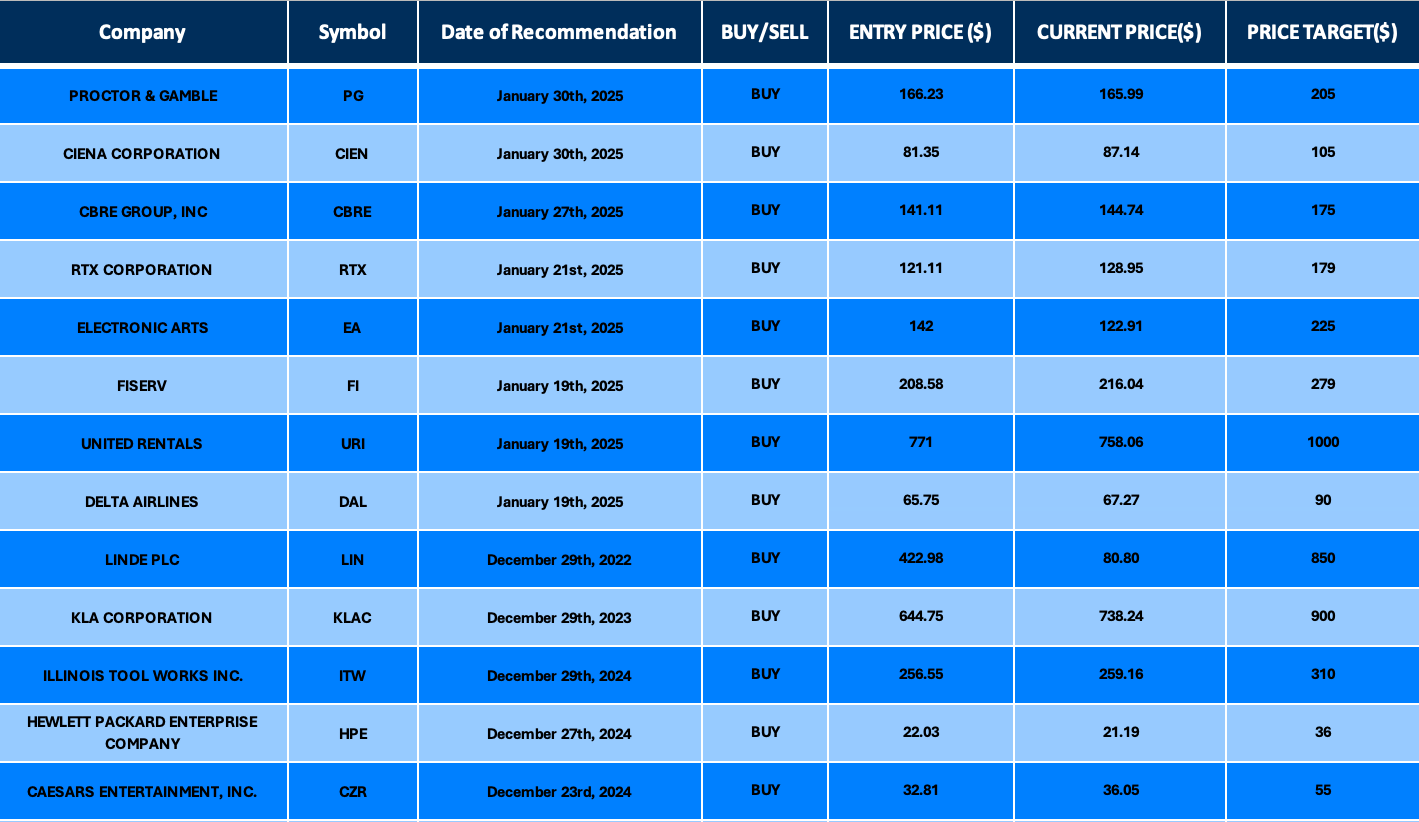
Disclaimer: This post provides financial insights for informational purposes only. It does not constitute financial advice or recommendations for investment decisions.
Daily Synopsis of the New York market close – Feb 4, 2025
Date Issued – 4th February 2025
Preview
Palantir shares surged over 23% on strong 2025 revenue forecasts, fueled by rising AI demand and US defense contracts. Meanwhile, a strong US dollar has spurred $54 billion in outflows from emerging Asian markets, pressuring currencies and equities, though supply chain shifts may benefit nations like Vietnam and Malaysia. Copper and zinc prices climbed as Trump delayed tariffs on Canada and Mexico, easing trade tensions temporarily. OpenAI and Kakao announced a partnership to develop AI products for South Korea, with OpenAI considering investment in the nation’s $1.4 billion AI computing center. Salesforce, under pressure to maintain profit margins, is cutting 1,000 jobs while hiring for its AI sales team, signaling a focus on high-growth tech innovation.
Palantir Surges Over 23% on Explosive AI Demand
Palantir Technologies saw its shares skyrocket by over 23% after releasing a bullish 2025 revenue forecast of $3.75 billion, exceeding Wall Street’s $3.54 billion expectation. The Denver-based company attributed this growth to “untamed organic demand” for its AI software. In 2024, Palantir’s stock surged 340%, fueled by growing commercial and government adoption of its data analysis tools.
Fourth-quarter revenue climbed 36% to $827.5 million, surpassing forecasts of $775.9 million, with US government sales up 45% and US commercial revenue up 64%. CEO Alex Karp highlighted Palantir’s deepening role in US defense, including partnerships with military branches, Ukraine, and Israel. The company also strengthened alliances with tech firms like Anduril and Anthropic, signaling a shift toward a software-led defense ecosystem.
Investment Insight: Palantir’s robust performance and expanding ties with US defense underscore its growing dominance in the AI space. Investors should monitor its ability to sustain growth amid political and budgetary shifts.
Market price: Palantir Technologies Inc. (PLTR): USD 83.74
Strong US Dollar Fuels $54 Billion Outflow From Emerging Asia
A surging US dollar, driven by Donald Trump’s new tariffs, is amplifying pressure on emerging Asian markets, which have already seen $54 billion in stock outflows over the past seven months. The stronger dollar limits room for interest-rate cuts in the region, while trade tensions and inflation concerns further strain economies like Indonesia, China, and India.
Currencies, including the Australian dollar and Indian rupee, plunged as US tariffs on China, Mexico, and Canada were announced. The MSCI Asia Pacific Index fell 4.4% since Trump’s election, while the Bloomberg Dollar Spot Index hit its highest level since November 2022. Analysts warn that a stronger dollar often drives investors toward safer US assets, exacerbating capital flight from emerging markets.
Singapore, Malaysia, and Vietnam may stand to gain as companies diversify supply chains away from China.
Investment Insight: The strong US dollar poses ongoing risks to emerging Asian equities. Investors should tread cautiously, focusing on resilient markets and sectors benefiting from supply chain shifts.
Copper and Zinc Rise as Trump Delays Tariffs on Canada, Mexico
Copper and zinc prices climbed after President Donald Trump postponed 25% tariffs on Canada and Mexico by a month, easing trade tensions and weakening the US dollar. Copper, a key industrial indicator, gained 0.7% to $9,159 a ton on the London Metal Exchange, while zinc and aluminum also saw modest increases.
The tariff delay follows agreements by Canada and Mexico to bolster border control measures, temporarily averting a continental trade war. Meanwhile, uncertainty persists as the US considers implementing tariffs on China, with talks between Trump and Chinese President Xi Jinping potentially on the horizon.
Investment Insight: Base metals show resilience amid easing trade tensions, but volatility will persist as US-China tariff decisions loom. Investors should monitor commodity-driven sectors and currency shifts closely.

OpenAI and Kakao Partner to Develop AI Products for South Korea
OpenAI and South Korea’s Kakao announced a strategic partnership to create AI products tailored for the Korean market. Kakao plans to integrate OpenAI technology into its offerings, while OpenAI CEO Sam Altman emphasized South Korea’s critical role in global AI development during a press conference in Seoul.
Altman also met with executives from SK Group and Samsung, highlighting the importance of South Korean companies like SK Hynix and Samsung Electronics, which produce key memory chips for AI processors. OpenAI is “actively considering” joining South Korea’s $1.4 billion national AI computing center initiative, aligning with the country’s ambition to lead in AI infrastructure.
Investment Insight: OpenAI’s expansion into South Korea underscores the region’s strategic importance in AI hardware and software innovation. Investors should monitor South Korean tech firms poised to benefit from growing AI partnerships and infrastructure investments.
Market price: Kakao Corp (KRX: 035720): KRW 40,450
Salesforce Cuts 1,000 Jobs While Expanding AI Sales Team
Salesforce is laying off over 1,000 employees as it begins its new fiscal year, even as it ramps up hiring for sales roles tied to its AI product line. Displaced workers will have the opportunity to apply for other roles within the company. This move follows broader workforce reductions across the tech sector, including Amazon, Microsoft, and Meta, as firms balance innovation with profitability.
Salesforce, with nearly 73,000 employees as of January 2024, is under pressure to maintain profit margins after scrutiny from activist investors. The company remains focused on scaling its AI-powered tools like Agentforce while improving operational efficiency.
Investment Insight: Salesforce’s dual strategy—cutting costs while investing in AI—highlights its pivot to growth in high-demand tech sectors. Investors should watch its upcoming earnings and AI product performance as key indicators of success.
Market price: Salesforce Inc (CRM): USD 339.24
Conclusion
The global landscape is shifting as AI innovation drives growth, trade tensions reshape markets, and companies balance efficiency with expansion. Palantir’s explosive growth underscores the rising demand for AI, while OpenAI’s partnership with Kakao highlights South Korea’s pivotal role in the AI ecosystem. At the same time, Salesforce’s dual strategy of layoffs and AI-focused hiring reflects the balancing act across tech industries.
However, challenges persist, with a strong US dollar pressuring emerging markets and trade uncertainties fueling volatility in commodities. Investors should stay vigilant, focusing on sectors poised for growth amid these evolving dynamics.
Upcoming Dates to Watch
- February 4th, 2025: Alphabet, UBS, BNP Paribas earnings
- February 5th, 2025: Eurozone HCOB Services PMI, PPI
- February 6th, 2025: UK rate decision, Amazon earnings
- February 7th, 2025: US nonfarm payrolls, unemployment; Canada unemployment
Find below some of our Buy/Sell Recommendations. Balfour Capital Group is a distinguished global boutique investment management firm with $350 million AUM and over 1000 Clients.

Disclaimer: This post provides financial insights for informational purposes only. It does not constitute financial advice or recommendations for investment decisions.



